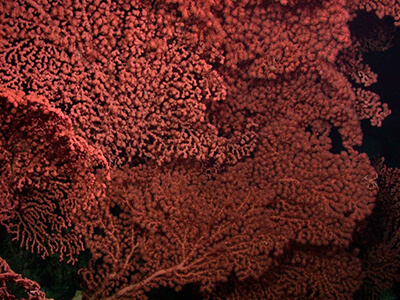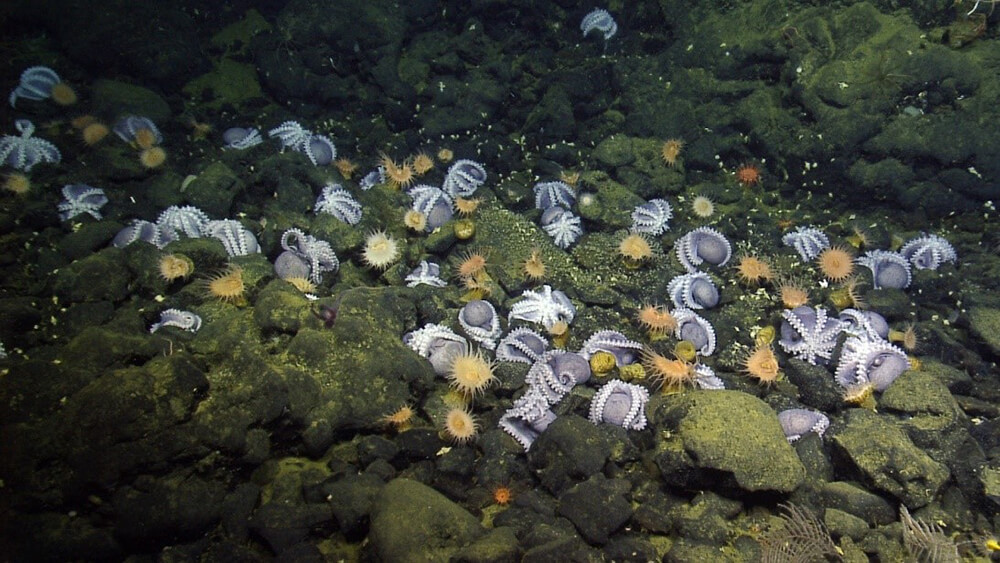Ecological Characterization of Davidson Seamount

Conservation Issue
The unique habitat and organisms associated with Davidson Seamount need to be characterized and studied to assess management needs for resource protection.
Description
Studies indicate that seamounts function as deep-sea “islands” of localized species distributions, dominated by suspension feeders (e.g., corals) that grow on rock in an otherwise flat, low-biomass, sediment-covered abyssal plain. Recent discoveries of octopus nurseries and warm water flow have highlighted the reason why additional exploration and research is necessary at Davidson Seamount. Monterey Bay National Marine Sanctuary (MBNMS) needs to increase understanding of Davidson Seamount through habitat characterization and the study of ecological processes so that the sensitive and long-lived species found there can be protected. Human threats include bio-prospecting, cumulative impacts from collection of long-lived species for research, new or unknown forms of seafloor disturbance, new technologies to harvest from the seabed, ocean acidification, and marine debris/dumping.
Data and Analysis Needs
- Temporal changes in the biologic community living on or near Davidson Seamount
- Taxonomy and natural history of described or rare species found on the seamount
- Age structure of the coral community living on Davidson Seamount, and whether these corals can be used to restore historical coral populations in more impacted areas of the sanctuary via translocation
- Length of time required for octopus to brood their young in warm water seeps
- Minimum octopus population and estimated reproductive potential on Davidson Seamount
- Fauna found within warm water seeps and their ecological roles
- Species that use mid-water and sea surface areas above the seamount
- Effects of oceanographic conditions, including pH, on regional ecology
- Historical role of Davidson Seamount in mapping, fishing, whaling, and research, as well as its historical and geological relationship to other seamounts
- Ecological links between the seamount and other sanctuary habitats (e.g., migration pathways and nutrient transport)
- Role of Davidson Seamount exploration in furthering understanding of basic seamount ecology
- Water quality monitoring at Davidson Seamount
Potential Products
- Education programs and visitor center displays
- Site characterization document
- Interactive online products (story maps, interactive maps, etc.) that document all exploration conducted at Davidson Seamount, with links to additional information, videos, articles, etc.
Suggested Scientific Approach and Actions
- Conduct regular biologic surveys of habitats associated with Davidson Seamount with remotely operated vehicles and submersibles
- Create high-resolution maps and photomosaics with autonomous underwater vehicles
- Count marine mammals and seabirds above Davidson Seamount
- Sample prey association with tucker and other trawling techniques
- Sample oceanographic variables through the entire water column
- Sample for environmental DNA from surface to seafloor
- Sample for anthropogenic pollution in the water column and seafloor sediments (PCBs, POPs, microplastics, etc.)
- Conduct deep-water coral ageing and restoration studies
- Explore to locate additional warm water seeps and octopus nurseries around Davidson
Key Partners
Monterey Bay Aquarium Research Institute, Moss Landing Marine Labs, Monterey Bay Aquarium, National Centers for Coastal Ocean Science, National Evolutionary Synthesis Center, National Marine Fisheries Service, Ocean Exploration Trust, Woods Hole Oceanographic Institute, Point Blue Conservation Science, Applied Marine Sciences

For more information about this assessment, contact Bridget.Hoover@noaa.gov.

